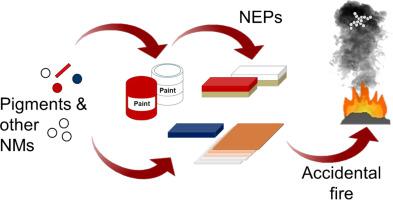NanoImpact ( IF 4.9 ) Pub Date : 2021-03-10 , DOI: 10.1016/j.impact.2021.100307 Tobias Hammer 1 , Nathan Bossa 2 , Michael Persson 3 , Adrian Wichser 4 , Ken Lehner 4 , Emmanuel Ruggiero 5 , Ana Sofia Fonseca 6 , Milijana Jovic 7 , Sabyasachi Gaan 7 , Wendel Wohlleben 5 , Jing Wang 1

|
Accidental or open waste burning and incineration of nano-enabled products (NEPs) might lead to the release of incidental aerosols in the nano size range into the environment resulting in harmful effects on humans.
We have investigated combustion-generated aerosol release during accidental burning for several real-life NEPs such as paints with silica (SiO2) and spruce wood panels containing SiO2 and Fe2O3 nanomaterials (NMs), paper with SiO2 and Fe2O3 NMs and polymeric composites with CuPhthtalocyanine NMs in poly lactic acid (PLA), polyamide 6 (PA6) and thermoplastic pol-urethane (TPU) matrices.
Chemical compositions, aerosols number emission factors (nefs) and concentrations of the signature elements of the NMs of the combustion-generated aerosols were investigated. In addition, the residual ash was analyzed. The outcomes of this study shed light on how NM and matrix types influenced the properties of the released aerosols. Based on our results it was established that the combustion-generated aerosols were composed of transformed NMs with modified physical–chemical characteristics compared to the pristine NMs. In addition to aerosols with transformed NMs, there were also particles due to incomplete combustion of the matrix.
Types of the pristine NMs and matrices affected the characteristics of the released aerosols. Since the effect of the aerosols is related to the inhaled aerosol number concentration, the nef is an important parameter. Our results showed that the nefs in the size range of 5.6 to 560 nm depended strongly on the type of combusted NEP, which indicated that the NEPs could be categorized according to their potential to release aerosols in this size range when they were burnt. The generated release data facilitate the assessment of human and environmental exposure and the associated risk assessment of combustion-generated aerosols from NEPs.
中文翻译:

纳米产品燃烧产生的气溶胶数量排放因子的重要性
意外或露天焚烧和焚烧纳米产品 (NEP) 可能会导致纳米尺寸范围内的偶然气溶胶释放到环境中,从而对人类造成有害影响。
我们研究了几种现实生活中的 NEP 在意外燃烧过程中燃烧产生的气溶胶释放,例如含有二氧化硅 (SiO 2 ) 的油漆和含有 SiO 2和 Fe 2 O 3纳米材料 (NM)的云杉木板,含有 SiO 2和Fe 2的纸聚乳酸 (PLA)、聚酰胺 6 (PA6) 和热塑性聚氨酯 (TPU) 基质中的O 3 NM 和含铜酞菁 NM 的聚合物复合材料。
研究了燃烧产生的气溶胶的 NM 的化学成分、气溶胶数量排放因子 (n efs ) 和特征元素的浓度。此外,分析了残余灰分。这项研究的结果揭示了 NM 和基质类型如何影响释放的气溶胶的性质。根据我们的结果,确定燃烧产生的气溶胶由转化的 NMs 组成,与原始 NMs 相比,其物理化学特性有所改变。除了具有转化的 NM 的气溶胶外,还有由于基质燃烧不完全而产生的颗粒。
原始 NM 和基质的类型影响释放的气溶胶的特性。由于气溶胶的影响与吸入的气溶胶数浓度有关,因此n ef是一个重要参数。我们的研究结果表明,尺寸范围为 5.6 至 560 nm 的 n ef强烈依赖于燃烧的 NEP 的类型,这表明 NEP 可以根据其在燃烧时释放该尺寸范围内的气溶胶的潜力进行分类。生成的释放数据有助于评估人类和环境暴露,以及对来自 NEP 的燃烧产生的气溶胶的相关风险评估。



























 京公网安备 11010802027423号
京公网安备 11010802027423号